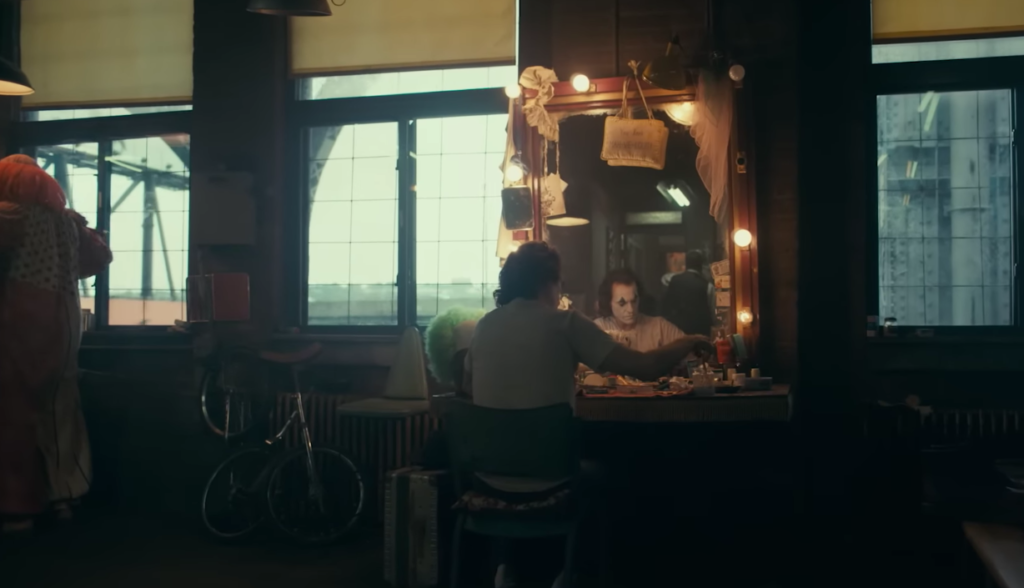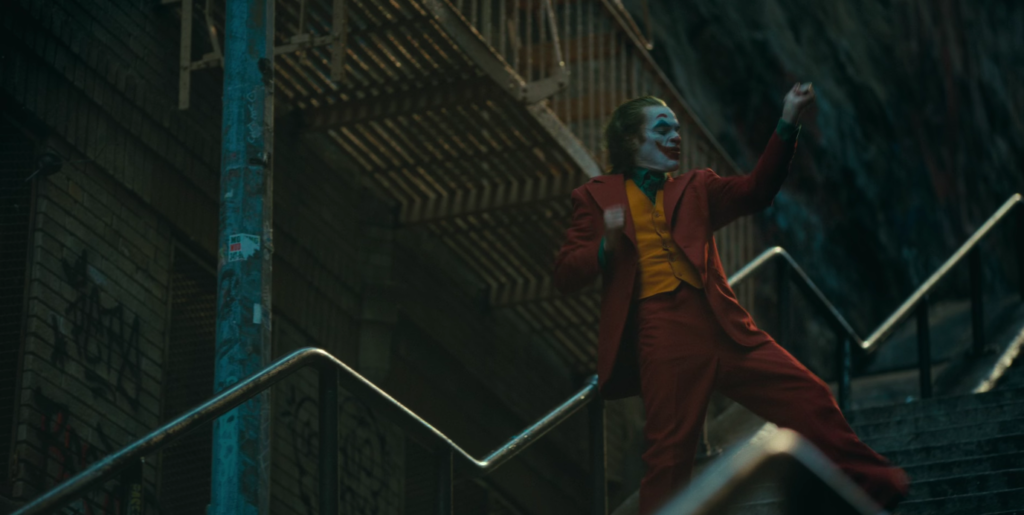
The sound editors find the sound sources whereas the sound mixers compile them all together to create a cohesive soundtrack/piece.
The Shepard Tone – Named after Roger Shepard, is a sound consisting of a superposition (a technique where two or more separate images or sequences are layered over each other to create a single frame) of sine waves separated by octaves. When played with the bass pitch of the tone moving upwards and downwards, it’s referred to as the Shepard Scale.
Diegetic Sound – Sounds which the characters on the screen can hear/are aware of.
Non-Diegetic Sound – Sounds which the characters on screen can’t hear but the audience can.
Examples of diegetic/non-diegetic sounds in ‘Joker’:

(diegetic) In this opening scene, we can hear a distant radio chatter playing as Arthur is posing in the mirror at his workplace. This audio is also heard by the characters in this scene, it acts as a narrative device, setting the world which ‘Joker’ is set in.

(non-diegetic) This is a good example of a non-diegetic scene as there’s music playing over the scene as he’s dancing down the stairs.
Sound Effects
Sound effects are artificially created or enhanced sounds that are used in artistic works to emphasize or express at action, emotion or feeling. Sound effects were initially used in radio dramas, but can be observed more often today in podcasts, theatre, films and television shows.
Foley Artist
A Foley Artist adds in (foley)sound effects to the movie in post-production. It is recorded in a sound proof studio, then the audio is layered over top of the images.
Leitmotif
A leitmotif/leitmotiv is a short, recurring musical phrase associated with a particular person, place, evolution of a character or idea. It conditions the audience to subconsciously recognise a character/idea/place even when it’s not in frame, solely due to a specific sound.
“Leitmotifs are guides to feelings” – Richard Wagner
For example, leitmotifs can be used to demonstrate a characters evolution, as shown in Star Wars with Anakin Skywalker, and his descent into evil as he becomes Darth Vader – the theme song is automatically linked with his character whenever the audience hears it.
As for setting, an example of this leitmotif can be found in Lord of the Rings, specific musical pieces are assigned accordingly to certain settings and how they’re supposed to make us feel.
For a particular person/thing, Jaws successfully represents the shark with a simple theme song, so we know it’s there before we even see it (which we hardly do) – the music makes its presence known, which is effectively unsettling.
Sound Bridge
A sound bridge is a technique which aids the seamless transition between two clips/scenes. This is done by using L-Cuts (the audio from the 1st clip carries over to the 2nd clip) and J-Cuts (the audio from the 2nd clip begins near the end of the 1st clip).
Films that use voiceover: Lolita (1997). I think it was used a lot in this film to emphasize the fact the Humbert is a very unreliable narrator.
Voice overs are typically used to narrate what is occurring, but it’s often only from one perspective – therefore, may be unreliable.
Score/Underscore
A score is the theme music composed especially for it to enhance the mood/themes of the visuals that appear on screen.
Underscores is the music which plays beneath the dialogue in the scene.
Synchronous/Asynchronous Sound
synchronous sound is sound that is matched to the action being viewed.
asynchronous sound is sound which is not matched to the actions and movements being viewed.
Needle Drop: when a pre-existing song is used in a film to underscore a particular scene.
Sound Perspective
The apparent distance of a sound source, evidenced by its volume, timbre, and pitch. In the clip from Spielberg’s ‘Munich’, where you can hear Daniel Craig’s character singing even though he’s not in the shot (yet), this automatically puts the audience in a perspective.
Film Score
My favourite film score is from Twin Peaks: Fire Walk With Me, composed by Angelo Badalamenti, and being co-written by David Lynch himself, is a jazz/ambient soundtrack. I love this one because of its ominous and beautiful composition, which is very fitting for a David Lynch psychological horror film; it manages to lure in the audience into the world of Twin peaks, and in this case, especially the character of Laura Palmer, adding to the haunting storyline of her character, as we already know what happened to her in Twin Peaks (TV show).